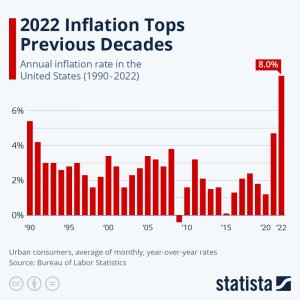J
ae Kim
@JaeKim1089208
"Other notable increases include jet fuel (+12.5%), home heating oil and distillates (+14.9%), and No. 2 diesel fuel (+11.8%). Trade services margins increased 2.0%, and machinery/equipment wholesaling rose 3.8%.Some categories like fresh fruits and melons fell 5.9%, and gasoline prices declined by 1.8%."
GROK:
The Producer Price Index (PPI) data released on August 14, 2025, indicates significant month-over-month increases in jet fuel (+12.5%), home heating oil and distillates (+14.9%), and No. 2 diesel fuel (+11.8%). These fuels, all petroleum-based distillates, share similar production processes and market influences, and their price spikes in the PPI reflect a combination of supply, demand, and external factors. Below, I outline the primary reasons for these increases, drawing on the PPI context and broader market trends:
- Crude Oil Price Fluctuations:
- Jet fuel, No. 2 diesel, and home heating oil are derived from crude oil, and their prices are heavily influenced by crude oil market dynamics. While some forecasts suggest Brent crude oil prices averaged $74 per barrel in September 2024, recent geopolitical tensions or supply chain disruptions may have driven short-term crude oil price spikes by August 2025, impacting the PPI. For instance, the Russia-Ukraine conflict has disrupted global oil supplies since 2022, and any escalation or new sanctions could tighten supply further, pushing up distillate prices.
- Refinery Constraints and Reduced Distillate Supply:
- Global refinery closures, such as those expected in Europe (e.g., Scotland’s Grangemouth) and the U.S. (e.g., Phillips 66’s Los Angeles refinery), are reducing distillate production capacity by about 1 million barrels per day in 2025. Since jet fuel, diesel, and heating oil are produced together in the refining process, lower refinery output directly reduces supply, driving up producer prices as reflected in the PPI. New refining capacity in Asia may not fully offset this due to regional demand differences.
- Surging Jet Fuel Demand:
- The PPI’s jet fuel price increase (+12.5%) aligns with strong global demand for air travel, which has returned to pre-pandemic levels and is projected to grow by 300,000 barrels per day in 2025, particularly in Western Europe and China. Refiners are prioritizing jet fuel production to meet this demand, which can strain supplies of other distillates like diesel and heating oil, contributing to their price increases (+11.8% and +14.9%, respectively). Limited adoption of sustainable aviation fuel (SAF), which is costly and constitutes only 0.7% of jet fuel production, keeps reliance on traditional jet fuel high, supporting price hikes.
- Seasonal Heating Oil Demand and Regional Factors:
- The +14.9% increase in home heating oil and distillates in the PPI likely reflects seasonal demand as winter approaches, particularly in the Northeast U.S., where over 80% of heating oil consumption occurs. No. 2 diesel and home heating oil are chemically similar, so heightened heating oil demand can also push diesel prices up, as seen in the +11.8% PPI increase. Regional supply constraints, such as limited pipeline capacity or low inventories, may amplify these price spikes.
- Geopolitical and Regulatory Pressures:
- Geopolitical events, such as OPEC+ decisions to delay production increases (e.g., until December 2024) or U.S. oil exports to support allies amid sanctions on Russian oil, have tightened global distillate supplies, impacting producer prices. Additionally, regulatory pressures like carbon pricing in the U.S. (e.g., the Regional Greenhouse Gas Initiative) and high diesel taxes in states like California (96.32 cents per gallon) increase production and distribution costs, which are passed on to producers and reflected in the PPI.
- Market-Specific PPI Dynamics:
- The PPI measures prices received by domestic producers at the first commercial transaction, so the reported increases (jet fuel +12.5%, heating oil/distillates +14.9%, diesel +11.8%) may reflect short-term market tightness or higher refining margins in August 2025. For comparison, a prior PPI report from August 2023 noted similar spikes in distillate prices driven by gasoline and diesel price surges, suggesting recurring seasonal or supply-driven patterns.
Summary: The PPI increases for jet fuel (+12.5%), home heating oil and distillates (+14.9%), and No. 2 diesel fuel (+11.8%) on August 14, 2025, are driven by a combination of rising crude oil prices, reduced refinery output, strong jet fuel demand from air travel recovery, seasonal heating oil demand in the Northeast, and geopolitical/regulatory pressures tightening supply and raising costs. These factors have converged to create supply-demand imbalances, pushing up producer prices for these closely related distillates.
The 38.9% MoM spike in fresh and dry vegetables stems from extreme heatwaves and droughts in key US regions like California, causing crop damage, reduced yields, and supply shortages.






